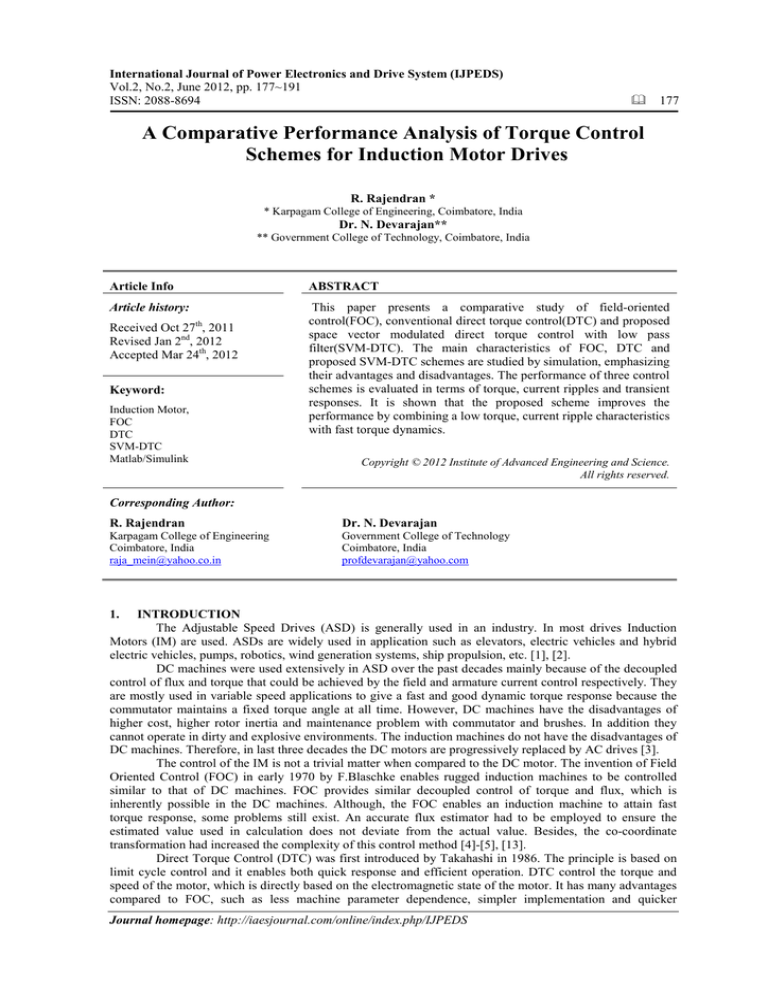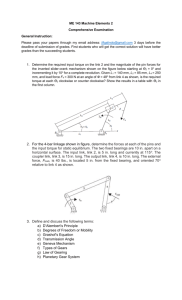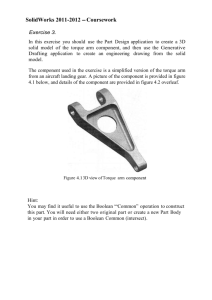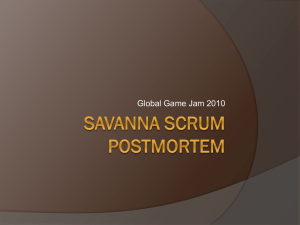
International Journal of Power Electronics and Drive System (IJPEDS)
Vol.2, No.2, June 2012, pp. 177~191
ISSN: 2088-8694
177
A Comparative Performance Analysis of Torque Control
Schemes for Induction Motor Drives
R. Rajendran *
* Karpagam College of Engineering, Coimbatore, India
Dr. N. Devarajan**
** Government College of Technology, Coimbatore, India
Article Info
ABSTRACT
Article history:
This paper presents a comparative study of field-oriented
control(FOC), conventional direct torque control(DTC) and proposed
space vector modulated direct torque control with low pass
filter(SVM-DTC). The main characteristics of FOC, DTC and
proposed SVM-DTC schemes are studied by simulation, emphasizing
their advantages and disadvantages. The performance of three control
schemes is evaluated in terms of torque, current ripples and transient
responses. It is shown that the proposed scheme improves the
performance by combining a low torque, current ripple characteristics
with fast torque dynamics.
Received Oct 27th, 2011
Revised Jan 2nd, 2012
Accepted Mar 24th, 2012
Keyword:
Induction Motor,
FOC
DTC
SVM-DTC
Matlab/Simulink
Copyright © 2012 Institute of Advanced Engineering and Science.
All rights reserved.
Corresponding Author:
R. Rajendran
Dr. N. Devarajan
Karpagam College of Engineering
Coimbatore, India
raja_mein@yahoo.co.in
Government College of Technology
Coimbatore, India
profdevarajan@yahoo.com
1.
INTRODUCTION
The Adjustable Speed Drives (ASD) is generally used in an industry. In most drives Induction
Motors (IM) are used. ASDs are widely used in application such as elevators, electric vehicles and hybrid
electric vehicles, pumps, robotics, wind generation systems, ship propulsion, etc. [1], [2].
DC machines were used extensively in ASD over the past decades mainly because of the decoupled
control of flux and torque that could be achieved by the field and armature current control respectively. They
are mostly used in variable speed applications to give a fast and good dynamic torque response because the
commutator maintains a fixed torque angle at all time. However, DC machines have the disadvantages of
higher cost, higher rotor inertia and maintenance problem with commutator and brushes. In addition they
cannot operate in dirty and explosive environments. The induction machines do not have the disadvantages of
DC machines. Therefore, in last three decades the DC motors are progressively replaced by AC drives [3].
The control of the IM is not a trivial matter when compared to the DC motor. The invention of Field
Oriented Control (FOC) in early 1970 by F.Blaschke enables rugged induction machines to be controlled
similar to that of DC machines. FOC provides similar decoupled control of torque and flux, which is
inherently possible in the DC machines. Although, the FOC enables an induction machine to attain fast
torque response, some problems still exist. An accurate flux estimator had to be employed to ensure the
estimated value used in calculation does not deviate from the actual value. Besides, the co-coordinate
transformation had increased the complexity of this control method [4]-[5], [13].
Direct Torque Control (DTC) was first introduced by Takahashi in 1986. The principle is based on
limit cycle control and it enables both quick response and efficient operation. DTC control the torque and
speed of the motor, which is directly based on the electromagnetic state of the motor. It has many advantages
compared to FOC, such as less machine parameter dependence, simpler implementation and quicker
Journal homepage: http://iaesjournal.com/online/index.php/IJPEDS
ISSN: 2088-8694
178 response. The configuration of DTC is simpler than the FOC system due to the absence of frame transformer,
current controlled inverter and position encoder, which introduces delays and requires mechanical transducer.
However, conventional DTC has several disadvantages such as difficulty to control torque and flux at low
speed, high current and torque ripple, variable switching frequency and high noise level at low speed [6][13].
Since conventional DTC was introduced in 1986, a large number of technical papers appear in the
literature mainly to improve the performance of induction motor. Two problems usually associated with DTC
drives which are: (i) variable switching frequency due to the hysteresis comparators used for the torque and
flux comparators and (ii) inaccurate stator flux estimations which can degrade the drive performance. Some
schemes have managed to maintain constant switching frequency and low torque and flux ripples by utilizing
space vector modulation with deadbeat torque and flux control [14], multilevel inverter [29], artificial
intelligence [26], matrix converter [25], adaptive flux observer [27] and eighteen sector switching strategy
[24]. All of these techniques however increase the complexity of the drive systems. Thus, the inherent simple
control structure of the conventional DTC drive is lost. In the case of stator flux estimation, it is estimated
based on the variation of the two types of estimators, namely, voltage and current models [32, 33]. To
maintain a speed sensor less operation, only voltage model has to be used [30]. In voltage model technique,
low pass filter (LPF) estimator is normally used in place of a pure integrator to avoid integration drift
problem [31].
Thus the objective of this paper is to give a fair comparison between the three schemes, FOC,
Conventioanl DTC and proposed SVM-DTC with LPF. The rest of the paper is organized as follows.
Section 2 presents the overview of FOC, Coventioanl DTC and proposed SVM-DTC with LPF. Section 3
gives the simulation results of all three schemes both in transient period and steady state period. Section 4
gives the comparisons of three schemes and finally, conclusions are given in section5.
2.
IM MODEL
The following equations written in terms of space voltage vector in a stationary reference frame
describe the dynamic behavior of an induction motor
ௗఒೞ
ௗ௧
ௗఒ
ܴ ݅ + ௗ௧ೝ
ݒ௦ = ܴ௦ ݅௦ +
0=
(1)
− ݆߱ ߣ
ߣ௦ = ܮ௦ ݅௦ + ܮ ݅
ߣ௦ = ܮ ݅ + ܮ ݅௦
Where ݒ௦ =[ݒௗ௦ ݑௗ௦ ]் is space vector of stator voltage, ߣ௦ = [ߣௗ௦
respectively the stator and rotor flux vectors,
݅௦ = [݅ௗ௦
݅௦ ]் and ݅ = [݅ௗ
(2)
(3)
(4)
ߣ௦ ]் and ߣ = [ߣௗ
ߣ ]் are
݅ ]் are respectively the stator and rotor current vectors.
(Rm, Rr) and (Ls, Lr) are respectively the stator and rotor resistances and inductances, Lm is mutual inductance,
߱ is motor angular speed in electrical rad/sec.
Also, the motor mechanical equation is
ௗ
߱
ௗ௧
்
்
= − − ߱
(5)
Where ܶ is the motor electromagnetic developed torque which is defined by:
ଷ
ܶ = ଶ ଶ (ߣௗ௦ ݅௦ − ߣ௦ ݅ௗ௦ )
(6)
2.1 Principles of FOC
The principle of the FOC is based on an analogy to the separately excited dc motor. In this motor
flux and torque can be controlled independently. The control algorithm can be implemented using PIregulators. In IM independent control of flux and torque is possible in the case of coordinate system is
connected with rotor flux vector. A block diagram of FOC scheme is presented in Fig.1.
IJPEDS Vol. 2, No. 2, June 2012 : 177 – 191
ISSN: 2088-8694
179
Figure 1 Block Diagram of FOC
The goal of FOC is to maintain the amplitude of the rotor flux linkage Ψ at a fixed value, except
for field weakening operation or flux optimization, and only modify a torque-producing component in order
to control the torque of the ac machine. This control strategy is based on projections. Electromagnetic torque
is produced by the interaction of stator flux linkages and stator currents (or rotor flux and rotor current), and
can be expressed as a complex product of the flux and current space phasors. In order to gain a complete
decoupling of torque and flux, the current phasor ݅௦ is transformed into two components of a rotating
reference frame: A flux producing component݅ௗ , aligned with d axis representing the direction of the rotor
flux phasor, and a torque producing component݅ ,aligned with the q axis perpendicular to the rotor axis.
Thus, the electromagnetic torque generated by the motor can be controlled by controlling the q-axis current.
This is equivalent to the torque control of a separately excited dc machine.
2.2 Principles of conventional DTC
The basic principle in conventional DTC for IM is to directly select stator voltage vectors by means
of a hysteresis stator flux and torque control as in Fig.2.
Figure 2 Block diagram of Conventional DTC
A Comparative Performance Analysis of Torque Control Schemes for Induction … (R.Rajendran)
180 ISSN: 2088-8694
Table 1 Switching Table for Conventioanl DTC
Sector
Flux
Δ߰
=1
Δ߰
=0
1
2
3
4
5
6
Torque
Δܶ
=1
V2 V3
V4 V5
V6
V1
Δ் = 0
V7 V0
V7 V0
V7
V0
Δ ் = −1
V6 V1
V2 V3
V4
V5
Δ் = 1
V3 V4
V5 V6
V1
V2
Δ் = 0
V0 V7
V0 V7
V0
V7
Δ ் = −1
V5 V6
V1 V2
V3
V4
From Fig.2 stator flux Ψ௦∗ and torque ܶ∗ are compared with the corresponding estimated values.
Both stator flux and torque errors are processed by means of hysteresis band comparators. In particular, stator
flux is controlled by a two level hysteresis comparator, whereas the torque is controlled by a three level
comparator. On the basis of the hysteresis comparators and stator flux sector a proper VSI voltage vector is
selected by means of the switching table given in Table 1.
2.3 Proposed SVM-DTC with LPF
On the subject of the SVM-DTC with closed-loop torque control, its control objective is to select
the exact stator voltage vector, ݒ௦ that changes Ψ௦ to meet the load angle reference, and so the desired torque
torque while keeping flux amplitude constant. A space vector modulation algorithm is used to apply the
required stator voltage vector. It is expected that torque ripple is almost eliminated, while zero steady state
error is achieved with fixed switching frequency. The stator flux can be directly obtained from the motor
model equation as follows:
௦ = ∫ ሺܸ௦ − ܴ௦ ܫ௦ ሻ݀ݐ
Ψ
(7)
Figure 3 Voltage model based estimator with pure integrator
Fig.3 is a classical voltage model of stator flux vector estimation, which obtains flux by integrating
the motor back EMF. The block diagram of this estimator is shown in Fig. This method is sensitive for only
one motor parameter, stator resistance. However, the implementation of pure integrator is difficult because of
dc drift and initial value problems. In order to eliminate these problems the authors proposed a new flux
estimator with low pass filter as shown in Fig.4, which eliminates problems with initial conditions and dc
drift, which appear in pure integrator. In this case the equation can be transformed as follows:
ೞ
ୢஏ
ௗ௧
= ൫ܸ௦ − ܴ௦ ܫ௦ ൯ −
IJPEDS Vol. 2, No. 2, June 2012 : 177 – 191
ଵ
்ಷ
௦
Ψ
(8)
ISSN: 2088-8694
181
Figure 4 Flux estimator based on voltage model with low pass filter
The block diagram of the method with low pass filter is presented in Fig.5.The estimator
stabilization time depends on the low-pass filter time constant ܶி .
Figure 5 Block scheme of SVM-DTC with Low Pass Filter
3
SIMULATION MODELS AND RESULTS
Each of the three control schemes are simulated using MATLAB/Simulink. The inputs to the
simulation model are the applied voltage and rotor speed. The model then calculates the stator current, stator
flux, rotor current, rotor flux, and torque. The simulation model is carefully arranged to avoid algebraic
loops. These are created when the output of a block is directly dependant on an input and that is obtained via
a feedback path directly from the output of that block. These algebraic loops can be avoided by arranging the
model such that there is an integral in each of these feedback paths. The dead-time and minimum-on time
requirements are also ignored such that the average output voltage produced matches the reference voltage.
A Comparative Performance Analysis of Torque Control Schemes for Induction … (R.Rajendran)
182 ISSN: 2088-8694
FOC
Conventional DTC
Proposed SVM-DTC
(a) Torque Response
(b) Current Response
(c) Current Response
(d) Three Phase Currents
Response
(e) Three Phase Currents
Response
Figure 6 Transient Response of FOC, Conventional DTC and Proposed SVM-DTC
with Low Pass Filter at 500 RPM
IJPEDS Vol. 2, No. 2, June 2012 : 177 – 191
ISSN: 2088-8694
FOC
Conventional DTC
183
Proposed SVM-DTC
(a) Torque Response
(b) Current Response
(c) Current Response
(d) Three Phase currents
(e) Three Phase currents
Figure 7 Transient Response at
100RPM
A Comparative Performance Analysis of Torque Control Schemes for Induction … (R.Rajendran)
184
FOC
ISSN: 2088-8694
Conventional DTC
Proposed SVM-DTC
(a) Torque Response
(b) Current Response
(c) Current Response
(d) Three Phase currents
(e) Three Phase currents
Figure 8 Transient Response at 1500 RPM
3.1
Transient Performance
The transient responses of the three control schemes are evaluated by simulating step changes in the
torque responses. Fig.6 (a)-(e) illustrates the torque responses; the current ripples obtained using FOC,
conventional DTC and proposed SVM-DTC at 500 rpm. Fig.7 (a)-(e) illustrates the torque responses, current
IJPEDS Vol. 2, No. 2, June 2012 : 177 – 191
ISSN: 2088-8694
185
ripples of FOC, conventional DTC, proposed SVM-DTC at 1000 rpm. Similarly, Fig.8 (a)-(e) illustrates the
torque responses, current responses of three control methods at 1440 rpm.The settling time of three control
methods are given in Table II.
Table II Settling time of the torque response
FOC
Conventional DTC
Proposed SVM-DTC
3.2
500
rpm
0.038s
0.027s
0.027s
1000
rpm
0.052s
0.038s
0.039s
1440
rpm
0.076s
0.056s
0.057s
Steady State Perfromance
The steady state performance of the three control strategies is evaluated based on the torque ripple
and on the current distortion. Fig.9 (a)-(e) illustrates the steady state torque ripples, the current ripples
obtained using FOC, conventional DTC and proposed SVM-DTC at 500 rpm. Fig.10 (a)-(e) illustrates the
torque ripples, current ripples of FOC, conventional DTC, proposed SVM-DTC at 1000 rpm. Similarly,
Fig.11 (a)-(e) illustrates the torque ripples, current ripples of three control methods at 1440 rpm. From these
figures it can seen that FOC and proposed SVM-DTC both exhibit very low torque ripple of 0.3Nm and
0.2Nm respectively. This is due to both schemes using space vector modulation to synthesise the voltage.
The average torque ripple for conventional direct torque control was 0.6Nm. The torque ripple of
three control strategies is given in Table III.
Table III Torque Ripples
500
1000
rpm
rpm
FOC
0.36Nm
0.32Nm
Conventional DTC
0.46Nm
0.48Nm
Proposed SVM-DTC
0.32Nm
0.34Nm
1440
rpm
0.29Nm
0.44Nm
0.31Nm
The simulated current waveforms are shown for each method. Again, FOC and proposed SVM-DTC
produce very low ripple due to the space vector modulation used to synthesize the voltage. Conventional
DTC is slightly more distorted current waveform. The current ripple of three control strategies is given in
Table IV.
Table IV Current Ripples
FOC
Conventional DTC
Proposed SVM-DTC
500
rpm
1000
rpm
1440
rpm
8.2mA
10.2mA
7.2mA
7.8mA
9.9mA
6.9mA
7.5mA
9.2mA
6.6mA
A Comparative Performance Analysis of Torque Control Schemes for Induction … (R.Rajendran)
186
FOC
Conventional DTC
(a) Torque Response
(b) Current Response
(c) Current Response
(d) Three Phase currents
(e) Three Phase currents
Figure 9 Staedy state Response at 500 RPM
IJPEDS Vol. 2, No. 2, June 2012 : 177 – 191
ISSN: 2088-8694
Proposed SVM-DTC
ISSN: 2088-8694
FOC
Conventional DTC
187
Proposed SVM-DTC
(a) Torque Response
(b) Current Response
(c) Current Response
(d) Three Phase currents
(e) Three Phase currents
Figure 10 Staedy state Response at 1000 RPM
A Comparative Performance Analysis of Torque Control Schemes for Induction … (R.Rajendran)
188
FOC
ISSN: 2088-8694
Conventional DTC
Proposed SVM-DTC
(a) Torque Response
(b) Current Response
( c) Current Response
(d) Three Phase Currents
(e) Three Phase Currents
Figure 11 Steady state perfromace at 1500 RPM
IJPEDS Vol. 2, No. 2, June 2012 : 177 – 191
ISSN: 2088-8694
189
4.
COMPARISON OF THE TORQUE CONTROL STRATEGIES
Induction motor torque control has traditionally been achieved using FOC. This is a relatively
simple but effective control scheme. Its disadvantages are that it requires an encoder to measure rotor speed,
it is sensitive to parameter detuning and the PI controller that regulates the stator current limits the transient
response.
The direct torque control scheme was later introduced to control the torque and flux directly based
on the instantaneous errors in the torque and flux. It does eliminate the encoder required to measure rotor
speed and has significantly higher dynamic performance due to the lack of the PI controller. The hysteresisbased switching of the inverter results in high torque ripple and current distortion.
The proposed SVM-DTC with low pass filter combines the features of FOC and conventional DTC.
Like the classical DTC, no encoder is required and the lack of a PI current controller results in a high
dynamic performance. The disadvantages of classical DTC are removed by the use of space vector
modulation that makes effective use of the inverter, resulting in low torque ripple and current distortion.
5.
CONCLUSION
This paper presented a comparison between three torque control methods for induction motor drive.
The description of three control schemes and their principle of operation have been presented. DTC was
developed as an alternative to FOC that had been in use for a number of years. DTC has the advantage of not
requiring speed or position encoders and uses voltage and current measurements only. It also has a faster
dynamic response due to the absence of the PI controller. A disadvantage of DTC is its comparatively high
current distortion and torque ripple. The proposed SVM-DTC with low pass filter combines the best features
of the DTC such as fast dynamic response as conventional DTC and low steady state torque ripple(32%
reduced) and current distortion(34% reduced). And compared to FOC the proposed scheme has 24%
improved torque response.
Nomenclature
Symbol
Definition
݅ௗ௦ ,݅௦
d and q components of the stator
current in stationary reference frame
݅ௗ ,݅
d and q components of the rotor
current in stationary reference frame
ܮ
Mutual Inductance
ܮ௦ , ܮ
Stator and Rotor Self Inductance
ܴ௦ , ܴ
Stator and Rotor Resistance
ܸ௦
ܸௗ௦, ܸ௦
ߣ௦
Stator Voltage
d and q components of the stator
voltage in stationary reference frame
Stator magnetic flux
ߣௗ௦ , ߣ௦
d and q components of the stator
magnetic flux
ߣௗ , ߣ
d and q components of the rotor
magnetic flux
A Comparative Performance Analysis of Torque Control Schemes for Induction … (R.Rajendran)
190
ISSN: 2088-8694
REFERENCES
[1]
[2]
[3]
[4]
[5]
[6]
[7]
[8]
[9]
[10]
[11]
[12]
[13]
[14]
[15]
[16]
[17]
[18]
[19]
[20]
[21]
[22]
[23]
[24]
[25]
[26]
[27]
[28]
[29]
B.K.Bose, Modern Power Electronics an AC Drives (Prentice-Hall, 2002).
Ward Leonhard, Control of Electrical Drives (Springler-Verlag, 1990).
Boldeea, I, Nasar, S.A, Vector Control of AC Drives (CRC Press Inc – 1992).
F.Blaschke, The principle of field oriented as applied to the transvector closed-loop control system for rotating
field machines,” Siemens Rev., vol.34: pp.217-210, 1972.
J.Holtz, E.Bube, Field Oriented asynchronous PWM for high performance AC machine drives operating at low
switching frequency, IEEE Transactions on Industrial Applications, vol.27: .574-581, 1991.
I.Takahashi and T.Noguchi, Quick torque response and high efficiency control strategy of an induction machine,
IEEE Transaction on Industrial application, vol.22:820- 827, 1986.
I.Takahashi and Y.Ohmori, High-performance direct torque control of an induction motor, IEEE Transactions on
Industrial Applications, vol.25: 257-264, 1989.
D.Casadei, G.Grandi, and G.Serra, Effects of flux and torque hysteresis band amplitude in direct torque control of
induction machines, IECON’94 conference record, pp.299-304, 1994.
P.Tiitinen, P.Pohkalainen and J.Lalu, The next generation motor control method: Direct torque Control (DTC),
EPE J., vol.5:14-18, 1995.
J.N.Nash, Direct Torque control, induction motor vector control without an encoder, IEEE Transactions on
Industrial Applications, vol.33: pp.333-341, 1997.
G.Griva, T.Habetler, M.Pastorelli, and F.Profumo, Performance evaluation of a direct torque controlled drive in the
continuous PWM- square wave transition region, IEEE Transactions on Power Electron,vol.10:462-471, 1995.
C.Lascu, I. Boldea, and F.Blaabferg, A modified direct torque control (DTC) for induction motor sensorless drive,
Conf.Rec. IEEE-IAS’98, vol.1, Oct.12-15, pp. 415-422, 1998.
D.Casadei, F.Profumo, G. Serra and A.Tani, FOC and DTC: Two Viable Schemes for Induction Motors Torque
Control, IEEE Transactions on Power Electronics, Vol.17:230-248, 2002.
T.G.Habetler, F.Profumo, M.Pastorelli, Direct Torque control of induction machines using space vector
modulation, IEEE Transactions on Industrial Applications, vol.28:1045-1053, 1992.
T.Abe, F.Profumo, G.Griva, and T.Habetler, Evaluation of a high performance induction motor drives using space
vector modulation, Electromotion Journal, vol.2: pp.79-86, 1995.
C.Lascu, I. Boldea and F.Blaabjerg, A modified direct torque control (DTC) for induction motor sensorless drive,
Conference Record of IEEE- IAS’98, vol.1, pp. 415-422, 1998.
C.J.Bonanno, Li Zhen, Longya Xu, A direct field oriented induction machine drive with robust flux estimator for
position sensorless control,Conference Record of IEEE-IAS’95, vol.1 , pp.166-173, 1995.
J.Holtz, Sensorless control of induction motor drives, Proceedings of the IEEE, vol.90, pp. 1359-1394, 2002.
J.Holtz, Juntao Quan, Sensorless vector control of induction motors at very low speed using nonlinear inverter
model and parameter identification, IEEE Transactions on Industry Applications, vol.38:1087-1095, 2002.
Jun Hu, Bin Wu, New integration algorithms for estimating motor flux over a wide speed range, IEEE Transactions
on Power Electronics, vol.13: 969-977, 1998.
F.Jenni, D.Wueest, The optimization parameters of space Vector Modulation, Conference Record of EPE, vol.4,
pp.376-381, 1993.
D.Casadei, G.Serra, and A.Tani, Stator flux vector control for high performance induction motor drives using space
vector modulation, Electromotion Journal,vol.2, no.2, pp.79-86,1995.
D.Casadei, G.Serra, A.Tani and L.Zarri,Theoretical and experimental analysis of an induction motor drive based on
stator flux vector control, Electromotion Journal, vol.6, no.1-2,
R.A.Gupta, Rajesh Kumar, et.al ‛ Eighteen-sector switching strategy for torque ripple reduction of direct torque
controlled induction motor drive’, International Journal of Power Electronics, Vol.3, No.1,pp.26-41,2011.
Cai Bin-jun, Zhu jian-lin ‛A novel DTC-SVM method for induction motor fed by matrix converter’, International
Journal of Intelligent Systems and Applications, vol.2, No.1,pp.15-22,2010.
K. Naga sujatha, K. Vaisakh ‛A robust self-tuning fuzzy PI scheme for DTC induction motor drive’, International
Journal of Computer applications in Technology, Vol.42, No.1, pp.13-22, 2011.
Zhifeng Zhang, Renyuan Tang, et al ‛Novel direct torque control based on space vector modulation with adaptive
stator flux observer for induction motors’, IEEE Transactions on Magnetics, Vol.46, No.8, pp.3133-3136,2010.
S.Benaicha, R. Nait-said, et al ‛ A direct torque fuzzy control of SVM inverter fed induction motor drive’,
International Journal of Artificial Intelligence and Soft Computing, Vol.1, No.2-4, pp. 259-270, 2009.
S.Kuro, J. Rodriquez, et al ‛High performance torque and flux control for multilevel inverter fed induction
motors’‛ IEEE Tranactions on Power Electronics, Vol.22, No.6, pp.2116-2123,2007.
IJPEDS Vol. 2, No. 2, June 2012 : 177 – 191
ISSN: 2088-8694
191
[30] G.D. Andreescu, et al ‛Sensorless direct torque control of electrical drives based on flux estimator using integrator
with dc-offset correction loop’ Iranian journal o electrical and computer engineering’, Vol.2, No.2,126-133, 2003.
[31] R.Krishnan. ‛Electric Motor Drives Modeling, analysis and Control’, Prentice-Hall,2005.
[32] T.Abe, F.Profumo, G.Griva, and T.Habetler ‛Evaluation of a high performance induction motor drives using space
vector modulation’, Electromotion Journal, vol.2: pp.79-86,1995.
[33] C.Lascu, I. Boldea and F.Blaabjerg ‛ A modified direct torque control (DTC) for induction motor sensorless drive’,
Conference Record of IEEE-IAS’98, vol.1, pp. 415-422,1998.
Bibliography of authors
R.Rajendran Assistant Professor, Department of Information Technology, Karpagam
College of Engineering, Coimbatore, India. He received BE (EEE) from CIT and ME
(Electrical Machines) from PSG, Coimbatore in the year 2000 and 2006 respectively.
He is currently pursuing doctoral research at Anna University; Coimbaore.His research
area includes Electric Drives and Control, Automotive Power Electronics and Special
Machines and Controller.
Dr. N. Devarajan, Professor, EEE Dept., Government College of Technology,
Coimbatore. He received B.E (EEE) and M.E (Power Systems) from GCT Coimbatore
in the year 1982and 1989. He received Ph.D in the area of Control Systems in the year
2000. He published 85 papers in the national and international conferences. He
published 36 papers in international journals and 13 papers in national journals. Under
his supervision currently 15 research scholars are working and 8 scholars completed
their Ph.D. His areas of interests are control systems, electrical machines and power
systems. He is member of system society of India, ISTE and FIE.
A Comparative Performance Analysis of Torque Control Schemes for Induction … (R.Rajendran)



